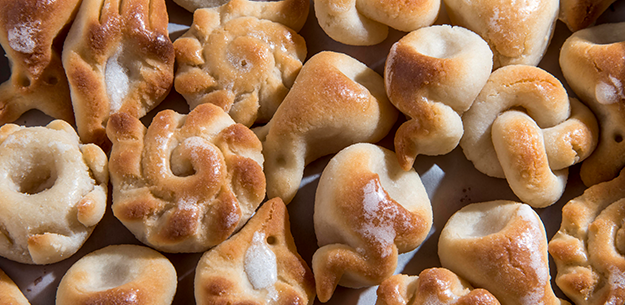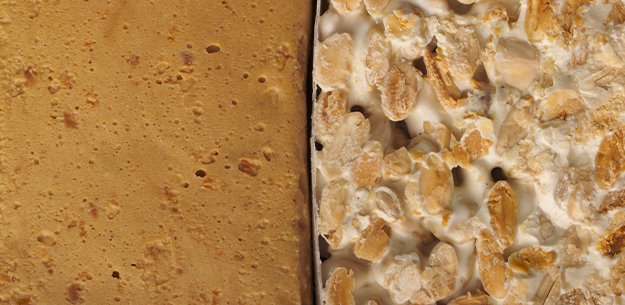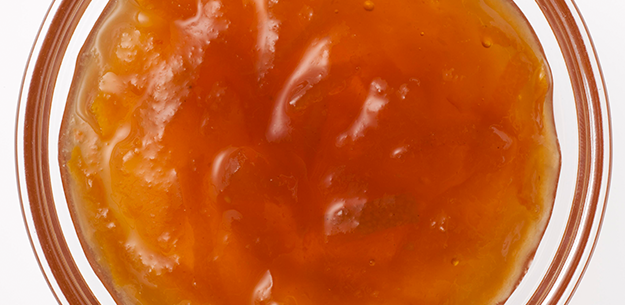.png.transform/rendition-xs/image_image%20(1).png)
Sweets
The Moors were known for their sweet tooth and it undoubtedly left an indelible mark on Spanish traditional patisserie and confections. Their recipes combining ingredients such as honey, sugar, almonds, walnuts, pistachios, spice, dates, and other dried or crystallized fruits are behind Spanish traditional confectionery.
Jam
Recipes for jams have figured largely in Spanish cook books since the 17th century. The invention of preserves in the 19th century led to the industrialization of many artisan jam-making processes in important fruit-growing areas like Murcia, Valencia and La Rioja.
The range of jams and jellies produced in Spain today is huge, and covers not only traditional fruits, but also tropical fruits and even some vegetables like tomato, onion and pepper.
Quince paste is a thick jelly made by cooking this fruit with an equal amount of sugar. Tracing back to Roman times, it is tremendously popular in Spain, where it is generally served in slices with fresh or cured cheese.
Chocolate
The Spanish word chocolate was the name given by Spaniards to a drink made by the Aztecs – the result of crushing cocoa beans and mixing them with water, pepper and achiote seeds, and sometimes maize and fruit.
The flavor of this original chocolate was bitter and spicy, but, when combined with sugar, chocolate fast became a fashionable drink, first in the colonies and then back in Spain.
By the 17th century, chocolate had become an essential afternoon drink for Spanish aristocratic women, and the custom soon spread throughout the upper classes in Europe.
The rising popularity of chocolate was closely linked to that of sugar. Chocolate gradually stopped being mixed with pepper, and ingredients such as milk and vanilla were added. The increasing demand for cocoa led the Spaniards to set up plantations outside Central America, mainly in Venezuela, and for many years it was one of the main commodities in international trade.
Technological progress in the 19th century helped improve the extraction of cocoa butter and raise the quality of chocolate in general, allowing it to be consumed not only as a beverage but also in bars and bonbons.
In Spain, chocolate is produced today both industrially and on a small, artisan scale. The variety is enormous, characterized by great creativity and imaginative presentations. And Spanish chocolatiers often use locally-produced fruits and nuts as added ingredients.
Turrón
Turrón is a clear example of the Spanish gastronomic inheritance from Arab cuisine. The honey, sugar, almonds, hazelnuts, walnuts and pistachios which the Moors used in large amounts in their pastries continue to be its basic ingredients. Turrón and marzipan are the most typical Christmas confections in Spain, a gastronomic tradition that has persisted for over five centuries.
Jijona in Alicante, where the Moors planted many almond and other fruit trees in the 8th century, is the birthplace of turrón. Today this area boasts the Protected Geographical Indication (PGI) Jijona y Turrón de Alicante, and the two types of traditional turrón that are produced here (Jijona and Alicante) are made from honey, sugar, roasted almonds and egg whites, following recipes that are over 500 years old. In Alicante-style turrón the almonds are left whole, whereas in the soft Jijona style they are crushed
The almonds used are generally of the native Marcona variety, considered one of the best in the world. Other authorized varieties are Valenciana, Mollar and Planeta.
In Catalonia, PGI Turrón de Agramunt is highly prized. Made in the province of Lleida, this golden, sweet and crunchy product is sold in disc form or as rectangular bars in two versions: almond and hazelnut.
Alongside these traditional varieties, many others have been developed in recent years – with truffle, chocolate, fruit, liqueurs or egg yolk – all of which have become very popular.
Traditional patisserie
The Moors were known for their sweet tooth and it undoubtedly left an indelible mark on Spanish traditional patisserie and confections. Their recipes combining ingredients such as honey, sugar, almonds, walnuts, pistachios, spice, dates, and other dried or crystallized fruits are behind Spanish turrón, marzipan, alfajores, panellets, garrapiñadas, almond and pine nut dragées, and many other sweets and candies.
The alfajores from Medina Sidonia, in the province of Cádiz, represent the quintessence of this tradition. They are made with honey, almonds, flour and breadcrumbs and are flavored with coriander, clove, aniseed, sesame and cinnamon.
The Moors’ sweet pastries fried in olive oil served as inspiration for the popular Spanish churros, buñuelos, tortas, rosquillas and other ‘fruits of the frypan’ (the name given in Spain to any dessert made from a fried flour dough).
Marzipan and other essential sweets
The historic city of Toledo (Castile-La Mancha) is the home of exquisite traditional confectionery, and particularly marzipan. The Ruling on the Toledo Guild of Confectioners, approved by King Philip III in 1615, defined its basic ingredients – peeled, ground, raw almonds and sugar. In its many presentations and varieties – Delicias, Marquesas and Glorias – the exquisite Toledo marzipan is guaranteed under PGI Mazapanes de Toledo.
One of the best-known baked pastries in Spain is the PGI Ensaimada de Mallorca, traditional festive fare since at least the 17th century. The dough, which includes eggs, sugar and lard, can be stuffed with pumpkin jam, known in Spanish as cabello de angel.
The recipe for the famous PGI Mantecadas de Astorga from the town of Astorga in León, is a masterly combination of flour, eggs, sugar, butter and lard, resulting in geometrically-presented golden, light sponge cakes.
Cocas are very popular in Catalonia and along the east coast of Spain. The dough for these oval-shaped pastries that are typical of the St John’s Eve festivities is flavored with crystallized fruit, almonds, lemon rind and cinnamon.
Huesos de santo combine almond marzipan with sweet egg yolk candy and are standard fare for November 1st. Other egg-based confections are yemas de Ávila or yemas de Santa Teresa, delicate candied egg yolks typical of the city of Ávila (Castile-León). Another is egg-yolk pudding (tocinillo de cielo). This recipe was originally created to use up the egg yolks left over after using the whites for clarifying the Sherry wines from Jerez and Montilla-Moriles.
Honey
Honey has been an essential ingredient in sweets on the Iberian Peninsula since Roman times. It continues to be as popular as ever and it is used in a huge range of desserts and confections, the main one in Spain being the traditional turrón.
Honey is tremendously varied, as its flavor, color, appearance and nutritional value can fluctuate from one hive to another. In Spain there are multi-flower honeys when the nectar comes from different sources, and single-flower honeys, from a single plant species.
In Andalusia, the Protected Denomination of Origin (PDO) Miel de Granada honey can be made with chestnut, rosemary, thyme, avocado and orange blossoms. For its part, the rosemary and lavender honey produced in PDO Miel de La Alcarria (Castile-La Mancha) has been famous since the 17th century. And the honey from PDO Miel de Tenerife reflects the huge diversity of vegetation on this Canary Island.
The most famous honey in northern Spain is PGI Miel de Galicia, which is made from eucalyptus, chestnut, blackberry or heather. Other noteworthy Spanish honeys include the orange-blossom honeys from the east coast, the rosemary honey from Alicante and many others from Madrid, Asturias, Castile-La Mancha, Basque Country and Extremadura.



- Sweets 1
- Sweets 2
- Sweets 3

